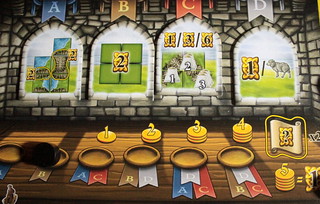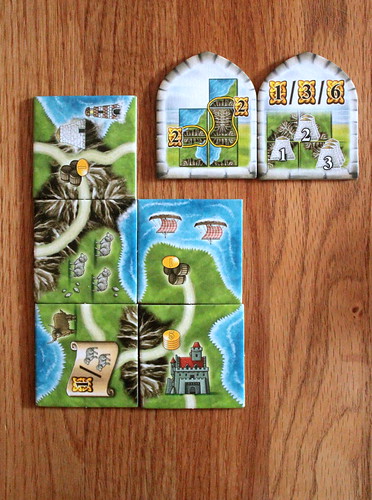| Strategy | Luck |
|---|---|
| Interaction | Components & Design |
| Complexity | Score |
Superficially, Isle of Skye has some similarities with Carcassone. Your goal is to assemble a landscape from square tiles showing formations of grassland, mountains and water that have to fit together where they connect to other tiles. But then the differences start. Unlike Carcassone, each player builds their own landscape over five or six rounds, depending on the number of players. After each round they score points according to four scoring rules drawn at the start of the game. You may be awarded points for lakes above a certain size, for sheep printed on your landscape tiles, for having the most whisky barrels – there’s a total of sixteen scoring tiles and they cover pretty much every possibility how you could count points for your tiles. That sounds like a typical point salad game, a game where everything you do scores points somehow, but since only four of those rules are active you will have to figure out how to best satisfy the combination you have in this game and focus tightly on doing that.

Not every rule scores after every round, either. After the first round you score according to the rule that went in slot A, after the second you score according to the rule in slot B, then you start scoring two or three rules every round. Which rules will score after which round is also known from the start, so in addition to focusing on the scoring rules the whole game you will focus more on the rules for this and maybe for next round to maximize your score. That gives you a lot to think about already, but there are tougher decisions still to be made.
In most other tile-laying games, you either draw one tile when it’s your turn, or you have a hand of tiles, one of which you select on your turn. Not so in Isle of Skye, here you have to buy the tiles you want from the other players. Each round, each player draws three tiles from the supply and places them, visible to everyone, in front of her player screen. Behind the player screen she marks one tile with the discard marker and the two other tiles with a price, using coins from her own fortune. When all players did that they remove their screens, they are only needed for players to mark their prices at the same time, without peeking what the others are doing. The tiles marked with a discard marker are removed.
Starting with a different start player every round, each player may buy one tile from another player. This is strictly optional, you can choose to hang on to your money as well. You hand over the price they set for that tile and take it for yourself. The seller takes your money as well as the money they used to mark the price immediately. A player taking his turn later may use the money he earned to pay for his own purchase. After all players had their chance to buy a tile they have to buy their own leftovers: any tile that wasn’t bought by another player goes to the player who originally drew it from the bag. The coins they used to mark the price are discarded in that case. Only then do all players place the new tiles in their landscape.

Buying tiles and setting prices for your own is where the real game happens, placing the tiles is just a reason to do it. Especially setting prices should be well considered. If you want a tile for yourself, you will want to set a higher price to keep others from buying it, but not too high, because you’ll have to pay it yourself. If you’re not so interested in your own tiles, you have to figure out what someone might be willing to pay for it. That means you have to guess how useful a tile might be to each of the other players based on their landscape, the other tiles available this round and the additional scoring rules printed on some tiles that will only apply to the player who owns that tile. Especially in five players, that means setting the prices can drag a little as there is a lot of information to take into account. In two players, this step is more boring because you can be certain to keep one of your tiles, there is no one around to buy the second – that makes the game more predictable, but in the case of Isle of Skye that also means more boring. You want the uncertainty of not even knowing how many tiles you will end up with to keep the game tends. Possible is any number from none when you didn’t buy a tile and both yours were bought to three when you bought one and kept both of yours. Getting fewer tiles is generally a bad thing since all the scoring rules reward having more of one thing or a larger one of another, but on the other hand not getting tiles now translates to having more money in the next round, another important trade-off to consider. So five players drags a bit, two players loses a core element of tension, it’s in three and four players that Isle of Skye truly shines.
And then it does shine. For a game that, from looking at it, seems like every players just plays for themselves Isle of Skye has a remarkable amount of interaction just from its pricing mechanic. It’s not the kind of interaction where you negotiate with other players and barter deals, but through your prices you influence what others can do and will want to do strongly and players should be aware of how everyone else is doing at all times to play effectively. That’s not as dry as it sounds, getting your prices just right is very satisfying. And even with some players prone to over-analyzing things, Isle of Skye takes an hour or less to play, you won’t have time to be bored.
In any other year, I would say that Isle of Skye has a good chance of winning the Kennerspiel award. This year it’s up against Pandemic Legacy and T.I.M.E. Stories, and that is going to be a tough battle. Both games use highly innovative mechanics that change the game from one play to the next, and that will be hard to go up against for Isle of Skye with its more traditional game mechanics, even if they are mixed in a new and attractive combination. If I’m right about this, that will mean that Andreas Pelikan and Alexander Pfister will miss out on the award this year, after winning it last year with Broom Service, a game that I personally enjoyed a lot less. The world is funny like that. Regardless of winning or not, though, I really like Isle of Skye. It’s a somewhat Carcassone-y game for real gamers, how could that ever be a bad thing?










